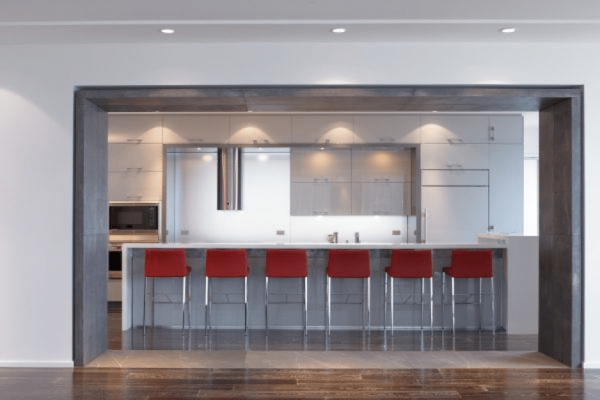Hiring An Interior Designer
There is a common misconception that interior designers exist to, “make things pretty.” Interior designers are professionals. They are experts in building and designing homes. In many ways, hiring an interior designer is like picking a doctor
Professional interior design goes beyond aesthetics. A doctor doesn’t just treat the symptoms, they make sure the entire system is healthy. Likewise, interior designers focus not just on beauty, but on functional & intelligent builds that make your space more usable. They also take into consideration how to work with the existing support systems like plumbing & electricity.
An interior designer helps you make sense of where to spend your money wisely. They help you see what potential issues are in the planning stages before construction starts and ensure that you have time to work through all the decisions without having last minute stress.
Hiring the right interior designer is essential to the health of your improvement project. It will also affect your happiness and the value of your property. With this in mind we have compiled some of the steps to take when hiring an interior designer.

Steps to hiring an interior designer
1. Consider Your Wants/Needs
Before you begin looking at hiring an interior designer, it helps to begin to form a picture of what you are looking for. Are you looking to do a full home renovation or a single room? This will impact what designers you look at. Some specialize in certain rooms, while others have experience coordinating and renovating entire houses.
Consider how the property will be used. A pied-à-terre, for example, does not have the same needs as a full-time home. Along the same lines, designing a family home has its own challenges and requirements for functionality.
In addition to functionality, you will want to start thinking about what styles you like. Some designers have a very specific style, and people will hire them to fit that look into their homes. If you want a design that is unique or personalized to you, you’ll want to find someone with a more diverse portfolio.
2. Research Interior Designers
As you look into styles, it’s a good time to start looking at designers. As mentioned above you can start looking at portfolios as inspiration and to discover work that appeals to your design sensibilities.
As you look into designers and styles, we encourage you to keep an open mind. There is no need to limit yourself to what the designer has already created. Your personality is not a cookie-cutter design, and your home doesn’t have to be either. Look for a designer who goes the extra mile to match the design to you, not the other way around.
As you look into interior designers, be wary of free design services. Naturally any free service is tempting, but home design is an investment. You get out what you put in. The free services aren’t built with a focus on design. The focus is generally on selling their own products.
These services use their company’s pre-designed templates. The creativity is limited to what they can produce. At the end of the day, you cannot ask them to build something they don’t want to build.
A professional interior designer isn’t trying to just fit products into your existing space. They are creating a space that is appealing and usable for you which may require some customizations that are specific to your project.
3. Deciding On A Budget
Having an idea of the budget you are working with will inform what can be done with your project. Trying to stretch a small budget too far may result in a finished product that you wish you had spent more on.
In the long run, doing a full home renovation at once comes out less expensive than doing each room over a series of years. But if you are working with a limited budget you may be better off focusing on a single or a few rooms. This ensures that you get a design you love, instead of making sacrifices to stretch the budget to work for your whole home.
When setting a budget, it’s important to be realistic with your expectations. Watching home renovation television shows can give a false sense of costs. The budgets they show often do not include service charges, labour costs, or factor in discounts. Sometimes, the numbers are fabricated altogether. Even when looking at projects online, the posted costs are often massaged. If you base your budgetary expectations on a TV show or article without knowing the details of how they calculated everything, it can result in some sticker shock. We have seen kitchen renovations that talk about the cost to change the cabinets as being “only 5,000.00” but upon closer examination it does not include removing the old cabinets, appliances, electrical changes, a new sink, flooring, counters, tile work……
An interior designer clearly defines where your budget goes. This clarity helps you see which aspects of the project are taking up the most budget. You can then adjust the plan to better match your goals.
4. Meet With Potential Designers
With an idea of your budget and your desires, it’s time to start meeting with the interior designers. At this point you want to look for a designer that is attentive and invested in your needs for this project. This is a time where you want to ask questions.
For one, find out if you will be working with the principal designer. You want them to have a genuine understanding of you and your desires for this project. With some firms you will never meet the principal designer or owner. Instead you will be relegated to meeting a member of the staff without knowing their particular skills or talents.
A key point in your interview is to watch how attentive they are to your questions. Do they listen, take notes and ask questions about you. Or do they talk about themselves without considering what your project needs are.
Hiring an interior designer is as much about the personal relationship as it is about the talents. You may find some interviews ‘click’ and that there is a comfort to the discussions. This is an important aspect as well. If you don’t have the confidence in the interior designer, you may start to second guess your decisions when stress levels start to rise later in the project and that can keep you awake at night. Make sure you feel comfortable discussing difficult subjects as well as the fun aspects.
As well, find out what other services the interior designer covers. Are they strictly design? If your project will require contractors or other teams and individuals being brought in, things can get complicated. An interior design firm that offers project oversight can make a big difference in how smoothly your project goes. They are better able to coordinate teams and communicate tasks, while keeping projects on time and on budget.
5. Hiring A Designer
Once you have decided on which interior designer to hire, there are a few last steps. These determine your needs and expectations, and set the project up for success.
A. Deciding on the designer’s involvement level.
How involved will the interior designer be? Are they focused on just the design, or are they providing project supervision? Will the designer be responsible for the materials used and selected or just a layout and space planning?
B. Level of communication
You will need a plan for communication touch points and the regularity/frequency of meetings. You also need to determine at which steps in the process you want to be involved. Are you hands on daily or do you want to walk away after the decisions are made and come back to a completed project without any mess or stress.
C. Working through the project
During the design phase there may be options and restrictions that need to be addressed. This may deviate from certain expectations you had set. Listen to your interior designer and take advantage of their expertise. In turn, they will also be trying to make sure any suggestions will suit your needs and wants. Every project has options for all situations, some may be obvious, others will require discussion. Good communication helps to ensure that everyone is comfortable with the final decision.
In addition to the project, you need to make plans for yourself. Before the work on your home begins, you need to make your own plans for accommodating the project. Will you be staying at home during the build? How will you have to adjust your home life during this period? If you are doing a full-home renovation you will probably want to find somewhere else to rent for a few months. Some people even choose to leave for the summer or a vacation or even stay with friends and family for smaller projects, to distance themselves from potential stress of living in a renovation.
Congratulations. With your interior design renovation planned and ready to go, you’re on the path to creating a new and exciting space. It’s an exciting adventure and with the right guide can be more than you ever imagined.
